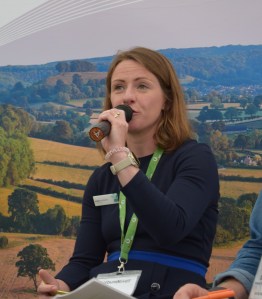Being the one-stop-shop for all things regenerative farming means Groundswell’s fan club continues to grow at a rapid pace. Now in its seventh year, CPM attended the festival to hear the latest perspectives on sustainable agriculture.
“For those thinking about a transition to regen, don’t change everything at once. Although there are still lows, among the many highs is finding happiness.”
By Janine Adamson and Emily Padfield

Getting to Groundswell early this year paid dividends as later arrivals found traffic approaching the event meant a lot of queuing.
It’s a much-quoted phrase – find a job you enjoy doing and you’ll never have to work a day in your life. For those attending Groundswell festival this year, that message couldn’t have been clearer.
Whether selecting a new break crop, integrating livestock into the rotation or diversifying the business, the show encouraged attendees to follow their passion and move away from what can sometimes prove a monotonous life.
And with 6500 visitors attending the event this year, that’s a lot of reignited passion ready to be invested into UK agriculture.

Talking about alternative break crops, Alice Andrews suggested choosing a crop you have an interest in or can become passionate about will inherently help it to be a success.
To illustrate, farming consultant Alice Andrews gave an example of how enthusiasm can translate into results during the ‘Rotation – mind the gap!’ panel session, which explored alternative break crops such as hemp and lupins.
“Choosing a crop you have an interest in or can become passionate about will inherently help it to be a success,” she said. “It enables you to persevere when things don’t always go to plan.”
Alice explained a successful break crop isn’t simply about making money and wider benefits should be considered. “Ask whether it supports using less inputs, can it fix N, does it facilitate livestock integration? Choosing a break crop which enhances biodiversity has the potential to boost the following cash crop,” she said.
It was a pursuit of happiness which encouraged Rebecca Mayhew to rethink the approach to her family’s South Norfolk farming enterprise. Formerly a 200ha conventional arable business with indoor pigs, the farm now boasts a range of pasture-fed livestock as well as a farm shop, butchery, restaurant and vineyard.
During the ‘Farming regeneratively and profitably’ masterclass at Groundswell, she said despite being efficient, the old business model was commodity-based, high risk and didn’t make the family happy.
“Our new approach spreads the risk and we control the price because products are sold direct to consumers. However, every part of the business has to earn its keep. For those thinking about a transition to regen, don’t change everything at once. Although there are still lows, among the many highs is finding happiness,” she said.

With 6500 attendees this year, there was no shortage of things to investigate as Groundswell further expanded what was on offer.
Diving deeper
Those looking for a deeper dive into regenerative farming, Groundswell hosted two advanced sessions for the first time – the first looking at integrated pest and disease management with Joel Williams.
During the first part of his talk, Joel spoke about diversity and biology and how mixing different tools gives the greatest chance of control. “A monoculture encourages pests to thrive but improving diversity breaks up uniformity and prevents widespread pest movement through integrating non hosts. This can be novel cash crops and widening the rotation, often doing the opposite of what you’re already doing – annual versus perennial or summer versus winter,” he said.
Joel explained diversity also includes agroforesty, silvopasture, intercropping and companion crops. It can even be as simple as letting grass grow which creates a space for beneficial insects to thrive. And importantly, this doesn’t have to be margins alone, it can be strips within a crop to support more productive field areas.
But ultimately, diversity can be broken down into three layers – temporal, spatial and genetic. “Temporal is diversity over time, for example, rotation changes. Spatial adds a physical barrier such as a buffer strip or field margin whereas genetic can be using varietal blends rather than a straight,” he said.
“The effect on disease pressure of increasing species diversity is it also increases pathogenic diversity. So by diluting the host, it’s harder for pathogens to proliferate and they can’t cause as much economic damage.
“Spatial separation can also give other integrated strategies more time to be effective, such as biological controls.”
To illustrate his point, Joel shared the benefits of intercropping in reducing weed, pest and disease pressure, including the mechanism of emitting plant volatiles to reduce insect feeding. “It’s back to breaking up the monoculture to make it easier for yourself,” he said.
Regarding biology, Joel believes a fundamental piece of the disease triangle (environment/host/pathogen) is missing, and that’s the soil and plant microbiome. “These beneficial organisms play a considerable role yet haven’t been factored in.
“To prevent disease, the microbiome works in various ways, from competitive exclusion of space, food and nutrients to antagonistic antibiotic and antifungal qualities. To maximise these benefits, we can either feed existing native organisms or introduce new populations,” said Joel.
Feeding biology can be achieved through keeping soil covered to continuously produce root exudates, using molasses or sugar, applying fulmic acids and plant extracts, or using organic amendments such as FYM or compost.
Whereas to introduce new biology, techniques include using commercial inoculants such as N-fixers, or creating DIY versions from compost and indigenous microbes. “Begin by approaching soil care first and then investigate top-up inoculants afterwards,” he added.
Although often plant tissue is under attack, Joel said it’s roots which have more power and activity against pathogens. “The rhizobiome shields plants from infection by releasing siderophores which uptake iron. They steal this essential resource from the pathogen, which is used for physiological processes such as DNA replication, transcription, metabolism and respiration.
“And when we discuss immunity, we really want the plant to recruit microbes from the soil via a signal to its roots in order to defend itself. This can be achieved through using seaweed-based biostimulant products or botanicals,” he said.
The second part of Joel’s talk focused on nutrition which he said starts with photosynthesis – the building block of plant life. “To fuel this function, as well as the obvious sunlight and water, plants require nutrients from the soil. These drive plant production and immunity, acting as catalysts,” explained Joel.
“And the product of photosynthesis is sugar, which is used to build complex sugars, carbohydrates, amino acids, lipids, hormones, vitamins, defense chemicals and protective compounds.”
He said it’s possible to select such compounds for preferred outcomes but it all relies on having the correct nutrients in the first place. Therefore, key pest and disease fighters can be specifically and intentionally managed.
To drill down further, Joel explained plants have two means of defence – physical, such as skin thickness and cell wall strength – and systemic biochemical, which is internal and reliant on the soil microbiome.
An example provided for improving physical defence was increasing cell strength to make a plant impenetrable to attack, achieved through optimising calcium, silicon and boron. Whereas calcium acts as both a nutrient and signalling messenger, boron provides a structural boost and is a synergist.
Silicon, although not essential, alleviates plant stress and reinforces cell walls. “It depends on where silicon is applied as to which insects are suppressed,” said Joel. “If it’s surface deposited, it’s ideal for chewers and borers but it also has the potential to be embedded in cell walls to deter sap suckers.”
He also highlighted the role of plant breeding in maximising soil nutrient scavenging. “Because some plant varieties are better at seeking nutrients than others, they’ll be more suited to lower input systems. Has this been neglected by breeders? Perhaps a discussion point,” he said.
N management was also a topic during the talk. Although the nutrient can have a positive effect on a plant’s physical status through improving the thickness of the cuticle (waxy outer layer), it also reduces lignen (main component of plant cell walls) production so increases lodging risk.

Joel Williams led the first ever intensive session at Groundswell which went beyond first principles and explained the science behind them.
Joel then explained converting nitrate- and ammonium-based N requires energy. “Why not feed the plant organic N to be more efficient, acting as a metabolic shortcut? Wasting energy deprives the photosynthetic process when it could be used to support tillering or flowering.
“Remember plants access N in other ways – urea, amino acids, peptides and proteins. These are favourable forms for plant health and immunity and therefore far more useful.”
Joel warned that N-rich plants can be more attractive to pests and diseases because they also have a demand for amino acids to build protein. However, it’s all about balance – a surplus of N compared with the other essential nutrients.
He also weighed up the pros and cons of pesticides which he said can undermine the protein creating process and make a plant vulnerable to pests and diseases. “Stress response in the plant triggers a protein break-down, converting it back into the initial building blocks in order to re-build as detoxification.
“We also see a spike in pest-appealing free amino acids during this process, all while potentially affecting beneficial insect populations. Mismanagement of both N and pesticides makes plants more attractive to insect damage so it’s crucial to stay within the optimum use zone,” he said.
Other nutrient examples provided were potassium and zinc. Potassium increases proteins, starches and cellulose in a plant which contributes towards complex protein production. By nature, a deficiency of this nutrient increases the occurrence of simple proteins which again lure insects. In contrast, heavy metal zinc is toxic to pests and pathogens including nematodes.
To conclude, Joel stressed the importance of integrated pest and disease management techniques. “In unfavourable conditions, it’s the main way to protect the lifecycle of pesticides while increasing plant health.
“Many knowledge gaps remain so instigating further research will be vital in creating a strong evidence base,” he said.
Underground chatter
How do plants communicate and what are they communicating with? Nicole Masters addressed these questions during the second deep dive session at the festival.
She began: “Take a moment to think about the last time you were hungry. What did you do? Did you make your way to the fridge? Did you tuck into your packed lunch? Did you call in at the garage for a quick fix?
“As humans, we’re in complete control of sourcing the materials we need to thrive. But plants aren’t. As farmers, we have to facilitate the correct over- and under-ground conditions for them to flourish.
“A plant’s endocrine system, its gut system and so much more is located outside of its body in the soil, so it outsources most of the functions humans take for granted.”
She described the soil as a living matrix – an underground metropolis full of constant underground chatter. “Billions of microbes build these cities, complete with hallways, tunnels and stairways. Here weave your earthworms, while bacteria form the building blocks, and fungi the mortar that holds it all together.”
Building on the metaphor, she continued: “Protozoa are using the bathroom, nematodes are weaving in and through the corridors. There are shops, schools, hospitals and even a pub. But what happens when we degrade these soil structures? Soils start to collapse.”
As many as 80% of New Zealand dairy farms have been surveyed as having significant compaction, indicating soils have collapsed and these all-important services have been lost, she added, and as a result, to get the same yields, more nitrogen has to be used.
Plant exudates act as a conductor for this underground chatter, sending out bundles of amino acids, sugars, hormones and organic acids to trade with microbes. “These carbon-based exudates act as payments to stimulate the microbes in turn for beneficial services, as well as providing communication signals to supress and defend against pathogens and pests.
“Not only this, but they also play a key role in aggregate stability as well as carbon and nitrogen dynamics.”
Nicole went on to discuss secondary metabolites – natural products predominantly made by bacteria, fungi and plants.
“Close your eyes and imagine you’re a microbe in this underground metropolis. How do you know how to get around? Who wants to eat you and who is a friend or foe? What is a food and what is poison? Who do you mate with?”
These microbes have no eyes, no ears and thus have adapted themselves to be able to communicate solely through secondary metabolites, she explained. “These secondary metabolites include things like phenolics, alkaloids, terpenoids, essential oils, flavonoids and the compounds that give nutrition and flavour to our food. They also form our antibiotics and drugs both medicinal and recreational.
“But the signals these produce are being disrupted by air pollution, nitrate and hydroxyl radicals, smoke, and a range of other factors. A study recently found some flowers are no longer sending out scent due to the amount of smog. They won’t invest energy into producing a secondary metabolites if nothing can hear the signal,” she said.
“Every single cell is waiting for a signal, but the environment effects how it is read. For example, a stressed environment fundamentally changes how every single cell signals to microbiology, both in flora and fauna.”
Stress also alters gene expression, she warns. Pesticides, herbicides, soluble fertilisers and neonicotinoids all alter a plants natural process of gene expression. “In fact, neonicotinoid application can alter as many as 600 genes. These are the same genes required for disease and pest resistance.
Nicole is picking up these effects in her practice. “Broadly, I’m seeing low functional calcium even on chalk soils, and the reason for this is the lack of beneficial fungi. This is the same for nitrogen, boron, copper, manganese, and zinc. It’s all down to a breakdown in how plants express these genes.
“But this also affects human health in the very same way, by altering the ability to be able to turn these genes on and off to build immunity.”
Nicole explained that biology is releasing volatile organic compounds (VOCs) all the time to move through soil and water to communicate from plant-to-plant, plant-to-microbe and microbe-to-plant.
“As a result, this plant can now synthesise plant hormones to respond to stress like flavonoids and defend itself. The key to all is this is that the plant can’t do this by itself, this communication happens outside of its roots. “Producing nutrient-dense food relies on a healthy microbial bridge and a healthy population of secondary metabolites.
“When a plant comes under some sort of pressure, it’s going to signal to produce things like quorum sensing molecules, antimicrobials which allows a plant to defend itself, as well as phytohormones and VOCs.”
Quorum sensing regulates the gene expression of certain types of organisms. “It’s what plants and microbes use to coordinate group behaviours to either collaborate or compete with other species.
“When populations are small, microorganisms are unable to express certain genes, as full gene expression requires a strong community. As numbers increase, autoinducer signals reach a threshold and gene expression now switches on. An example of this in humans can be a sore throat in response to a streptococcus infection.”
So what’s the impact of this in agriculture? “There are now wheat varieties that no longer communicate with mycorrhizal fungi. Although the plant will grow, it won’t have the same access to vitamins and minerals like phosphorus and zinc, and it won’t communicate through secondary metabolites as the relationship has been interrupted,” explained Nicole.
“So how a plant is grown or where you’re sourcing your seeds is critical. Does it come from a system that is full of chemicals with a tiny or non-existent seed microbiome, or can you farm save seeds that are more robust for your system?” she challenged.
“We’re now learning so much more about the seed microbiome, which can set you up for success or failure, particularly as we start to move towards lower input systems. Some modern varieties are simply not adapted to thrive without inputs.”
Nicole stressed the difference between commercially grown varieties and older varieties in terms of root systems and their ability to develop healthy, functioning and communicative rhizosheaths. “This can be the difference between a plant being drought, disease or pest resilient or not. Can this plant communicate with the microbiology beneath the soil?
“We have focused so much on what is happening on top in terms of production. It’s like breeding racehorses simply to run fast but forgetting they need good feet and a good temperament.”
The ability to tolerate challenging environments comes through both phenotypic (short-term changes as an individual) and epigenetics. “Epigenetic changes passed down through generations play a pivotal role in plant memory and priming plant defences to pests, diseases and climatic extremes. This in turn alters root exudates, as well as the expression and composition of primary and secondary metabolites.”
As is so often stressed in regenerative circles, diversity is the key – both above and below ground. “The more diversity we see in the soil system, the more plants communicate with microbes, and the more microbes communicate back to the plant.
Nicole highlighted ergothioneine as a prime example. “Ergothioneine is an amino acid produced by fungi such as bollate, oyster and lion’s mane mushrooms. All of these are full of this compound, and it’s being dubbed as the ‘longevity vitamin’ or ‘powerhouse nutrient’. Deficiencies have been linked to Parkinson’s Disease, Alzheimers and overall reduced life expectancy.
“What’s interesting is that ergothioneine is a secondary metabolite produced by soil fungi and is then taken up by the plant. But research suggests if you till your fields, it simply disappears.”
One possible mechanism linking soil disturbance to reductions in ergothioneine uptake is the decline in the population of arbuscular mycorrhizal fungi, she added.
So does that mean tillage is always a bad thing? Not according to Nicole.
“Yes, you can till but you have to ‘earn the right’. How do we achieve this? By feeding fungi every time you’re in the field and for every operation, think about how to feed the fungal biomass and how to encourage more and more diversity of the biology in the system.”
It’s questioning everything you do that Nicole explained was important. “Am I looking at my landscape and thinking ‘how do I get in sync with nature’, and ‘how do increase more vibrant life in my system’? If you follow these principles with every management decision, there’s a higher chance you’re going to be actively regenerating your soil.”
But that isn’t always the case, warned Nicole, who believes glyphosate use is counterproductive to soil health. “In the USA, growers plant somewhere in the region of an additional 50 million acres of cover crops last year, which is great. But they terminated these cover crops with glyphosate, so the use of the chemical also grew.”
She recommended thinking about how to achieve goals while all the time fostering microbiology.
“Maximising photosynthesis should also be a key consideration,” she added. “Your main role is to plug into the sun. How well is my plant capturing sunlight energy – do I have a diversity of solar panels to capture every piece of sunlight energy I possibly can?
“What I’ve seen of the UK so far is that your photosynthetic rate of capture is very low, and I suspect that’s down to minerals and trace element availability.”
With that in mind, Nicole advised delegated to get their diagnostic hat on. “Why are my plants not capturing sunlight energy? It’s this sunlight energy pushing sugars out of the root zone is what drives the afore-mentioned benefits.”
This article was taken from the latest issue of CPM. Read the article in full here.
For more articles like this, subscribe here.
Sign up for Crop Production Magazine’s FREE e-newsletter here.




